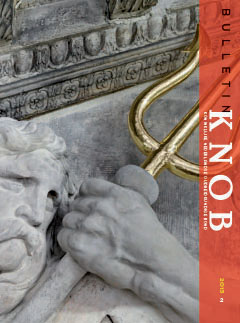Indexing ESCI / Scopus


Marie-Thérèse van Thoor: De restauratie van het Koninklijk Paleis Amsterdam. Pieter Vlaardingerbroek: Bouw- en restauratiegeschiedenis van het Amsterdamse stadhuis en paleis in vogelvlucht (1648-1968). Bert van Bommel: Terugblik op een geslaagd project. De restauratie van het Koninklijk Paleis Amsterdam. Hein Hundertmark: Zandsteen als architectonische expressie. Bouwhistorisch onderzoek in het Koninklijk Paleis Amsterdam. Anne van Grevenstein en Emilie Froment: Wegvliegen in het oneindige. De plafondschilderingen in het Koninklijk Paleis Amsterdam. Paul van Duin en Aagje Gosliga: Carel Breytspraak sr., hofleverancier van Lodewijk Napoleon. De Breytspraak-meubelen uit de collectie van het Koninklijk Paleis Amsterdam. Timo G. Nijland: Reinigen en retoucheren. De restauratie van de zandsteengevels van het Koninklijk Paleis Amsterdam. Pieter Vlaardingerbroek: Tussen concept en geschiedenis. Een analyse van de restauratie van het Koninklijk Paleis Amsterdam (2005-2011).
Between 1648 and 1968 there were three major stages in the building history of the town hall and Royal Palace. It was originally built in the period 1648-1667 as Amsterdam’s town hall and it was also the palace of the Republic: a visual symbol of power that was unparalleled anywhere else in the Dutch Republic. Its architect, Jacob van Campen (1596-1657), looked to biblical architecture and especially Solomon’s Palace and Temple for inspiration, taking his cues primarily from the book In Ezechielem explanationes et apparatus urbis ac Templi (Rome 1596-1604) by Juan Bautista Villalpando....
After 1968, few changes were made to the Royal Palace in Amsterdam and eventually the palace was no longer functionally and technically up-to-date. Initially, the most recent restoration was only aimed at remedying that situation. Also, the project was split up and priority was given to fixing up the interior. Gradually, the actual restoration gained prominence. In 2007 it was decided to also restore the 1808 furniture. Until 2006, the government architect had hardly been involved in the restoration of the interior. This architect, Krijn van den Ende, was advised by various...
Over the past few years (2006-2011), the former town hall of Amsterdam, which has been in use as Royal Palace since 1808, was restored. During the restoration work studies of both the building history and of the colour history were conducted. This research has yielded important information about the original colour scheme of the interior and has led to the conclusion that sandstone, specifically its colour, was an important element in the architectural expression. The atmosphere of the current interior of the Royal Palace is now defined by alterations made in the early 19th century and a...
In 1655-1656 the ceilings of the Weeskamer and the Thesaurie Ordinaris of the Amsterdam town hall were painted by Cornelis Holsteijn, that of the Justitiekamer by Nicolaes van Helt Stockade and that of the Burgemeesterskamer by Jan van Bronkhorst. The allegorical representations of justice, against the backdrop of a blue sky, are embedded in the architectural structure of the rooms on the first floor. In 2006, the Stichting Restauratie Atelier Limburg was commissioned to study the effects that natural aging and interventions done in the past had had on the linen canvas and the painter’s...
In 1808, King Louis Napoleon had the town hall of Amsterdam converted to Royal Palace. Besides making the necessary architectural alterations, he ordered hundreds of pieces of furniture and other ornamental objects from local furniture makers, upholsterers, decorators and other suppliers. This collection of Empire furniture, which is still preserved in the palace, is today the largest of its kind outside France. Between 2005 and 2009, these pieces of furniture were restored as part of the wider restoration of the entire palace, a gigantic operation that involved hundreds of restoration...
The Royal Palace in Amsterdam has the largest sandstone-cladded façade of the Netherlands, made of Obernkirchen and Bentheim sandstone. The façades already showed black weathering three quarters of a century after their construction. The formation of thin black weathering layers occurs in many types of sandstone. The layers are made up by various components, including airborne particles and bio colonization. The current paper relates the results of a decade of scientific research into the possibilities of cleaning blackweathered Obernkirchen and Bentheim sandstone without causing any...
The Royal Palace in Amsterdam (originally the town hall) was restored during 2005-2011. The restoration work was qualified as a state secret, which means that many architectural historical data are still not publicly available and that the local Department of Monuments of the city of Amsterdam does not have access to them either.
The restoration consisted of several elements.
1. The renovation of the palace and its technical systems. In 2006, one third of the Imperial staircase was removed to make room for a lift. This had a severe impact on the monumental value of the...
